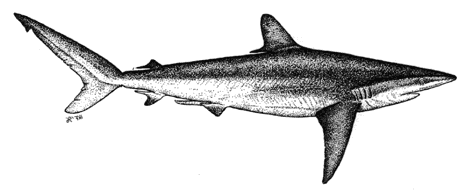Silky Shark(Carcharhinus falciformis)

(Bibron, 1839).
| Fr: |
Requin soyeux |
| Sp: |
Tiburon jaqueton |
| It: |
N/A |
| Ma: |
N/A |
Diagnosis
A large, somewhat slender shark with a moderately long and
slightly pointed snout; narrow interdorsal ridge. Eyes round
and quite large. First dorsal fin small (height ca. 5.2-10% of
TL) with a curved apex, origin posterior to the rear corner of the
pectoral fins; second dorsal fin noticeably small and low, with its
origin slightly ahead of the anal fin, and a long free rear tip over
twice as long as the fin height. Pectoral fins quite large but
slender, with their anterior margins measuring ca. 14.2 to 22% of TL
and narrowly-rounded or pointed apices. Upper-teeth
essentially triangular, becoming more oblique rearwards, strongly
serrated and deep indentations on the rearward edges; crown feet
with coarser serrations. Colour dark bronzy-grey or mid-grey
dorsally, fading to white ventrally with a poorly-defined white band
on the belly-flanks; fin-tips (with exception of 1st dorsal) rather
dusky.
Size
To 330 cm TL; usually to 300 cm; size at birth ca. 70 to 87
cm.
Status and Distribution
Mediterranean Sea: Rare or occasional; apparently as an
Atlantric vagrant into the Western Mediterranean, where it occurs in
the zone from Gibraltar immediately eastwards. Infrequently
taken at Gulf of Chafarinas (Morocco) and neighbouring sites (to
Algeria?); possibly more cosmopolitan, at least in the Alboran Sea,
than current records infer (preserved jaws of this species examined
by I.K. Fergusson at Favignana, Sicily). Not yet definitively
recorded from Sicilian Channel but a likely addition, given the
presence of other oceanic Atlantic vagrants such as C.
obscurus and Alopias superciliosus, and quite
likely to be recorded throughout the deeper, warmer zones of the
Mediterranean basins.
Biology
Poorly-known within the Mediterranean. An epipelagic or
semipelagic, oceanic and littoral shark found in warm-temperate and
tropical seas within the influence of land masses or islands, from
the surface to at least 500m; usually far from the coast over
continental or insular shelves; also at offshore banks, but
sometimes occurring nearer to shore over deep blue waters and even
over depths as little as 18 m. This species is apparently more
prone to making inshore excursions than its pelagic relatives,
Carcharhinus longimanus and Prionace glauca, and
may be less well adapted to a truly oceanic lifestyle. Silky
sharks are active, fast-moving predators of a variety of bony
fish, including tunas (with which they are commonly associated) and
other scombroids; also mullet and other coastal species; squid,
pelagic crabs and octopi. Segregation by size occurs, with
younger sharks nearer to shore. In the Western Atlantic,
pupping-zones occur over depths of 80-100 m. Litter size is 2
to 14 pups (average litter varies geographically), with no defined
breeding-season. Males mature at 187-217 cm, females at
213-230 cm.
The Shark Trust, 36 Kingfisher Court, Hambridge Road, Newbury, Berkshire, RG14 5SJ, UK.
Tel(+44) 01635 551150, Fax(+44) 01635
550230
|